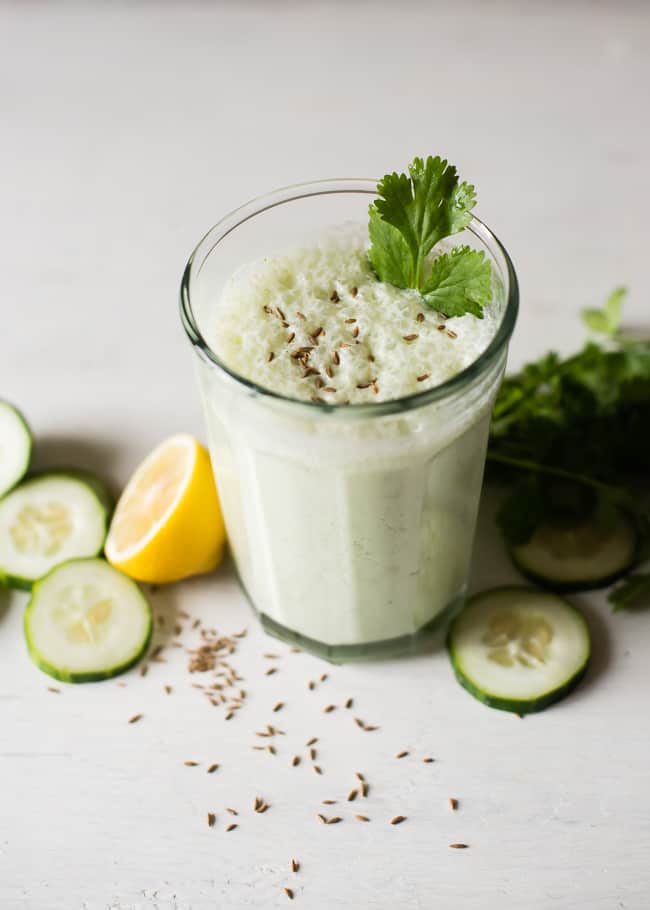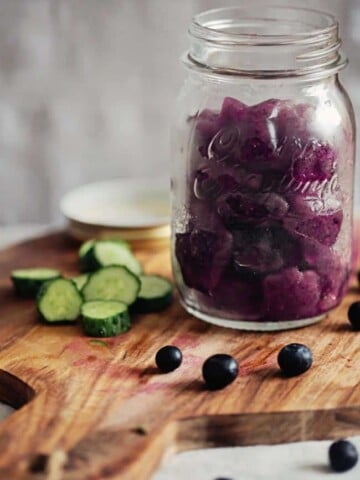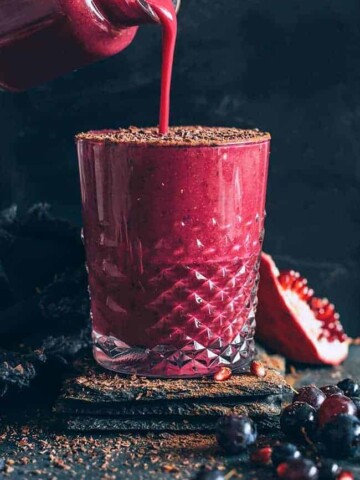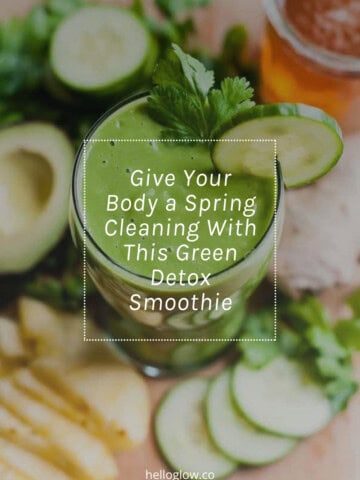Smoothies can be the ultimate health food but, thanks to the plethora of delicious fruits and add-ins we use to make them, they also have the potential to be a sugar bomb. Not that yogurt, juice, or fruit are bad for you, per se—but if you’re looking to lower your sugar intake or regulate your blood sugar (who wants to experience a sugar crash an hour after downing a “healthy” smoothie?), try making your smoothies with lower-sugar ingredients.
Consistently overdoing it on the sugar can defeat the purpose of your healthy smoothie and even negate some of its benefits. Here are a few ways to tweak your favorite smoothie recipe to be lower in sugar; a No-Fruit smoothie or the Detox Probiotic smoothie with Kefir pictured below is another great place to start!
How to Make a Low-Sugar Smoothie
1. Pick the right liquid.
Start with ¾ cup liquid and add more if needed. If you are using frozen fruits or veggies, you might need to add more. When using items with high water content like cucumber (which is also very low in calories) [source], you’ll need less.
Opt for: Water, cooled herbal or green tea, unsweetened green juice, lemon or lime juice, unsweetened kefir, unsweetened non-dairy milks (think cashew, almond, rice, or soy—homemade or store-bought)
Use sparingly: Fruit juice, sweetened or flavored non-dairy milks, carrot or beet juice, coconut water
Tip: If you find less-sweet smoothies too bland, try minimally diluting your juice or milk with water (or another low-sugar option) and gradually increasing the amount of water over a few weeks. Note that “plain” or “original” non-dairy milks don’t necessarily mean “unsweetened,” so check labels carefully!
2. Go for the green veggies.
Make sure to add veggies to your smoothies for extra nutrients, anti-inflammatory compounds, and antioxidants [source] and to minimize the sugar content. Start with about ¼ cup and go from there.
Opt for: Broccoli, cauliflower, kale, romaine lettuce, spinach, bell peppers, cucumber
Use sparingly: Carrots, beets, peas, squash
Tip: Frozen veggies are perfect for adding to smoothies and will help thicken them (especially helpful if you’re missing frozen bananas). Fresh will also work, but you may have to experiment a bit with your liquid ratio. You can also get your veggies by using a veggie juice for your liquid, although using the actual vegetable will ensure you’re getting the fiber.
3. Add supplements instead of sweeteners.
Spices, herbs, and nutritional smoothie add-ins help you get a more nutritional bang for your smoothie buck.
Opt-for: Spices, raw nuts, spirulina, hemp hearts, chia seeds, unsweetened protein powder, herbs, bee pollen, cocoa powder, probiotic powder, plain yogurt
Use sparingly: Flavored or sweetened protein powder, honey, maple syrup, dates, sweetened or flavored yogurt
Tip: Soak the nuts for a couple of hours to soften before adding to a smoothie. Check protein powders (even “plain” varieties) for sugar content before adding them in.
Cinnamon and cardamom are great add-ins to sweeten smoothies, while cilantro and parsley make great additions to veggie-based ones.
4. Scale back on the fruit.
Start with ½ cup of fruit and add more as needed to get your desired texture.
Opt for: Avocado, grapefruit, papaya, berries, cranberries
Use sparingly: Bananas, cherries, mango, figs, grapes, pineapple
Tip: Frozen fruits will add more of a thick, milkshake-like texture, and avocado will also help thicken. Frozen bananas are packed with health-promoting nutrients [source] and are the ultimate smoothie thickener. But, unfortunately, they have a high sugar content—15 grams each! Cut them into fourths before freezing, and add a little chunk to your smoothies for thickening power without a lot of sugar.
10 Nutritionist-Recommended Low-Sugar Fruit Options
It’s important to note that, when it comes to eating whole fruit, the sugar it does contain comes packaged together with lots of really great stuff like dietary fiber, antioxidants, vitamins, and minerals [source]. In particular, the fiber helps slow down the uptake of sugar into the bloodstream and keeps blood sugar stable [source].
Fruit juice, on the other hand, has had the fiber removed. Ever cleaned out a juicer? All that leftover roughage is what I’m talking about. So the sugar-to-fiber ratio is vastly different from that of whole fruit, and it has a different effect on the body [source].
Drinking a glass of orange juice will cause your blood sugar to spike way more than if you’d eaten a whole orange along with a glass of water. When making a smoothie from whole fruits, the fiber is retained [source], resulting in a protective effect on blood sugar levels.
1. Raspberries
Sweet, delicious red raspberries are like a low-sugar gift from mother nature. This phytonutrient-packed fruit has tremendous nutritional value and is considered one of the highest in dietary fiber. The antioxidant compounds heal inflammation and work to prevent cardiovascular disease, reduce symptoms of colitis, and improve blood pressure and glucose balance [source]. One cup of fresh or frozen raspberries contains just 5 grams of sugar.
2. Strawberries
Ripe, plump, juicy strawberries are so sweet and delicious that you wouldn’t think they’re likely to be low in sugar, but they are! A one-cup serving of strawberries yields only 7 grams of sugar. They are also little nutrient powerhouses, containing high levels of vitamin C and folate, along with many other vitamins, minerals, and anti-inflammatories [source].
Try: Strawberry Smoothie with Chia, Hemp & Flaxseed or Strawberry Smoothie for Healthy Hair
3. Blackberries
All berries are rich sources of protective polyphenols that keep those damaging free radicals in check, and blackberries are no exception [source]. In addition to being super high in antioxidants, blackberries are also a delicious low-sugar fruit. Like strawberries, they’ve got 7 grams of sugar per one-cup serving.
(Blueberries, unfortunately, don’t make the cut as they’ve got 15 grams of sugar per one-cup serving)
Try: Blackberry Coconut Smoothie Bowl
4. Grapefruit
This big, beefy winter citrus is a good option for a low-sugar fruit. A large grapefruit contains 7 grams of sugar per 100-gram serving or about 8 grams of sugar in half of a large fruit. They are a rich source of potassium like other citrus fruits but contain higher levels of zinc [source].
Try: Immune-Boosting Grapefruit smoothie
5. Watermelon
Not only is watermelon incredibly hydrating, but it contains phytochemicals with numerous health benefits. It reduces blood pressure, prevents cardiovascular disease, slows the growth of cancer cells, and helps with weight management by making you feel full [source]. It’s also a tasty low-sugar fruit. One cup of diced watermelon has just under 9 grams of sugar.
Try: Watermelon Smoothie with Coconut Water
6. Kiwi
High in vitamin C and known to help immune function [source], these fuzzy green fruits native to New Zealand are a good low-sugar choice with just 6 grams of sugar per fruit. A one-cup serving would contain about 16 grams of sugar, just for reference.
7. Lemons and limes
Although you’re not likely to sit down to a bowl of lime wedges, lemons and limes contain numerous therapeutic antioxidant compounds [source] that work to prevent inflammatory and age-related conditions [source]. They are both great options for low-sugar fruit with just over 1 gram of sugar each. They’re definitely a great way to add some pizzazz to your sparkling water!
Try: Green Detox Smoothie
8. Cranberries
Cranberries are not only beneficial for urinary health but they have been shown to lower cholesterol and blood pressure—and they are powerful antioxidants [source]. If you can handle the pucker, fresh cranberries are a great low-sugar fruit. They’ve got just 4 grams of sugar per cup. Be aware that most dried cranberries are sweetened, so they’re not a good option.
Try: Turmeric Berry smoothie with cranberry juice
9. Avocado
Did you know that avocado is technically a fruit? Like most other fruits, they are a good source of vitamins, fiber, and antioxidants. In addition, avocados contain healthy fats. With so many unique nutritional benefits, they could even be called a superfood [source]. A large avocado only contains about 1 gram of sugar in the entire fruit. Avocado lovers rejoice!
Try: Avocado Cinnamon Berry smoothie
10. Guava
Lastly, this little tropical fruit is a low-sugar treat. In fact, it has a history of use for the treatment of diabetes and menstrual disorders in Southeast Asia. Studies have shown it reduces cholesterol and blood pressure and contains anti-cancer compounds [source]. Guavas contain a little less than 5 grams of sugar per fruit, or 9 grams of sugar in a 100-gram serving.
Try: Replace the papaya in this Tropical Beauty smoothie with guava
Note: fruits do vary in size, weight, and sugar content, so the amounts given are based on the averages for standard serving sizes.
This article was medically reviewed by Dr. Gina Jansheski, a licensed, board-certified physician who has been practicing for more than 20 years. Learn more about Hello Glow's medical reviewers here. As always, this is not personal medical advice and we recommend that you talk with your doctor.
80





